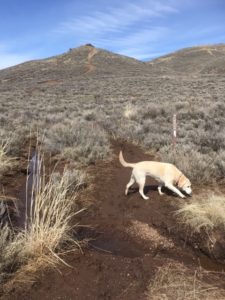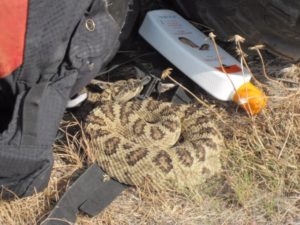The only venomous snake native to Idaho is the Western Rattlesnake (Crotalus viridis). Each spring snakes emerge from hibernation and we sometimes see them here and there in the valley. Democrat Gulch is one area where they are often spotted. Those walking dogs are encouraged to keep their pets on leash, as curious canines and rattlesnakes are a poor mix.
The Idaho Mountain Express has covered the topic of the annual emergence of pit vipers in the valley very well. The information in their articles, from local veterinarians and other experts, will be especially helpful to concerned recreationists and pet owners.
Idaho Mountain Express Article: With warmer weather, rattlesnakes emerge by Tony Evans June 20, 2018
Idaho Mountain Express Article: Rattlesnakes are emerging from dens by Tony Evans May 27, 2016.
Here is an article by Maria Grant titled: Do’s and Don’ts of hiking in rattlesnake territory. It is a very useful and informative guide about the precautions one can take when traveling in areas inhabited by venomous snakes.
I offer my considered, but non-expert opinions below.
Here is my take on how to avoid having any trouble with rattlesnakes. Don’t pester them when they announce their presence. In my limited experience with them I have always found them to be cowering under sagebrush or taking cover in some form. They want to let you know they are there, so that you don’t step on them. That is why they shake their rattles; to warn you off. They have no interest in biting you, unless they feel cornered or threatened.
I’ve had my share of encounters with rattlesnakes. Once, back in 2013, I returned from a day of work in the sun to find a rattler coiled up under my ATV. Actually, he was under my helmet, which I had stashed under the machine to keep it cool. The snake was docile and rattled at me when I used a very long stick to try to get him to move along. He kept trying to get back under the protection of the machine, but after multiple flips with the stick, into the brush, he finally scurried off. With all my poking and throwing him around he never once tried to strike out at me or the stick.
Rattlesnakes eat small prey; rodents and rabbits and such. They don’t want to use their venom on something they can’t eat. They want to warn you off. So back off and immediately heel your pets away. Don’t try to take a picture of the snake, don’t try to handle it. Move well around it and move on.
Please don’t get me wrong, I understand that people and their pets are sometimes bitten by snakes due to no fault of their own. Bites by pit vipers can certainly be life threatening, especially for kids, the infirm and elderly. Pets are certainly at risk of dying from a venomous snake bite, especially smaller animals. And the bite of these snakes can be incredibly painful with the recovery from bites often being arduous. But for humans, the chances are slim that you will be bitten, and if you are bitten, according to the U.S. Department of Wildlife and Ecology, your chances of dying from a venomous snake bite in the US is close to zero; 1 in 50 million.
In my opinion, in most cases, by listening and watching for them you can avoid undesirable encounters with rattlesnakes. And I think a few things are huge contributing factors as to why people often get bit. People who get bit continue to approach the snake after it has announced its presence. Rattlesnakes are very sensitive to heat and vibration and they know you are in the area. They sense your presence well before you can sense them. They give a warning, as if to say, “Stay away!” But some people and pets are too curious, or too stupid, to heed that warning. They further approach the snake – after they are aware of its presence. Then they try to take its picture, or handle it!
Males seem especially prone to this behavior, and some people feel compelled, for some reason, to kill any rattlesnake that they encounter. Occasionally I see dead snakes that have been laid along roadsides or trails; by people who have beheaded them. They seem to be announcing to the world that they have done mankind a service. Bah! If you are smart about it, these animals are no real threat to you or your pet. Besides, they fill an important role in the ecosystem.
I think male hubris and alcohol are much more likely to lead to rattlesnake bites than most anything else. In support of this hypothesis I point to several studies that were done to help determine what some of the factors were when people got bit. One study reviewed records of 86 rattlesnake bite victims from a single medical center. All victims were men and 64% of them were under the influence of alcohol. Another study found that in 227 cases at a single hospital, male victims outnumbered females 9-to-1. In this same study, 57% of the victims were handling a venomous snake at the time that they were bit, and 28 percent appeared intoxicated.
Guys! Studies and common sense suggest that people who have been drinking and handling venomous snakes are very likely to get bitten. Those who heed rattlesnake warnings are very unlikely to be bitten.
If bitten, do your best to stay calm, call 911 and get to a medical center. Keep the heart above the bite area. Don’t use tourniquets or ice, and no cutting or sucking – get medical attention.



